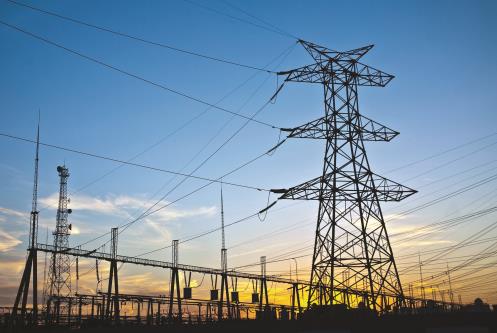Tower/Wireless Infrastructure
Primus provides a complete supply chain of tower equipment which allows citizens, businesses, and government to access information that is essential to the well-being and productivity of all.
Distributed Antenna Systems (DAS)
The public's enjoyment of cultural, entertainment, and sporting events is heightened with unlimited access to reliable communications. Primus' DAS technologies help you stay connected with solutions that deliver coverage and capacity with reliable wireless service in challenging environments.
Land Mobile Radio
From first responders to dispatched services with large vehicle fleets, Primus helps power your land mobile radio system with interoperability solutions that allow seamless communication between all units and those in need of assistance.
Public Safety
Primus works with Planning and IT officials from design through installation and operation so that key officials and departments experience totally reliable connectivity. These solutions create a better informed public and improved security through early warnings, pubic alerts, and disaster preparedness.
Utilities / Oil and Gas
An informed investment in telecom helps pave the way for next-generation energy solutions. Whether the need is for custom-designed or in-stock configurations, Primus provides the communications infrastructure that enables utilities to better monitor and control the production and delivery of power, gas, and electricity.
Transportation
Travelers have spoken: they want total connectivity at all times. Wi-Fi services and a power outlet at every seat can increase ridership. The wide-ranging telecom solutions available from Primus meet the demands of consumers and also keep dispatchers connected to trains, buses, trucks, and ships that transport people and cargo and foster economic growth.
Education
High-speed connectivity can increase enrollment through greater access to courses and study materials. When students can use remote learning, there are fewer absences caused by illness or truancy. Primus' communication solutions let school officials communicate swiftly with students, parents, employees, and neighbors. Primus delivers solutions that facilitate instruction and help protect people, buildings, equipment, and intellectual property.
Healthcare
Primus provides telecommunications solutions that enable healthcare professionals to monitor patient health remotely, prevent life-threatening events, and quickly connect with first responders.
Safety and Industry Training
Being safe on the job is not only a requirement, but also fundamental to completing a project on time. Primus has an extensive inventory of safety products from the highest quality manufacturers and is committed to helping customers acquire skills and competencies required to gain maximum value from product purchases and perform work safely.
Industry Training
Primus is excited to offer a number of classes, certifications, and educational presentations for your product and fall protection training needs. Click below to view popular trainings offered through our partners.
Anritsu - Access MasterTM OTDR

Course Description:
A 1-day, instructor-led course, Access Master™ OTDR Certification is another high-quality Anritsu training. An opening lecture uses physical demonstrations of how Fiber Optics work, to make the theory concrete and memorable. Hands-on labs are extensive, and small class size provides plenty of instructor coaching. Certification is based on participation in hands-on exercises and passing a brief, written exam.
What You Receive:
- Course Manual - full color
- Official Anritsu Certification - on passing practical exam (ID card is mailed after training)
- Use of Anritsu instruments and equipment during the training
- Small group instruction
- Expert instructors with years of real-world experience
Who Should Attend:
- Wireless Carriers
- Base Station OEMs
- Tower Companies
- Field Engineers
- Installers
- Site Managers
Agenda:
- Fiber Optic Theory
- Optical Connector Cleaning and Inspection
- OTDR Theory and Operation
Anritsu - Active DAS Certification

Course Description:
Active DAS Certification is a 3-day course that teaches the theory and practical considerations and procedures of assembling, installing, and testing the active portions of Distributed Antenna Systems. Upon successful completion, students will know how to use the instruments to make measurements, interpret and analyze information to find problems and correct them, and have sound strategy for consistent documentation and efficient, effective workflow. The purpose and true value of this course is that it will teach students to do the job correctly the first time avoiding costly rework.
Anritsu's Active DAS Certification offers:
- 60% hands-on practice with the Access Master
- Instructor-led by an expert with 15 years of DAS engineering and installation experience
- All required tests and troubleshooting practiced on a Corning 1 Active DAS simulation they built
- Daily tests on theory to self-assess progress throughout
- Practice reading and interpreting industry-standard documentation and engineering parameters
- Hands-on fiber splicing and skills evaluation
Who Should Attend:
- Indoor/Outdoor DAS Installers
- DAS Project Managers
- DAS System Test Technicians
- Wireless Carriers
- Base Station OEMs
- Field Engineers
- Site Managers
Prerequisites:
- Familiarity with line sweeping and PIM testing principles and equipment are required to pass this course
- Line Sweep Certification and PIM Certification are strongly recommended prior to attending this class
- Though not required, the following free eLearning courses are highly recommended for anyone preparing to attend DAS Certification training:Site Master Line Sweep Web-Based eLearning Course, Line Sweep Interpretation Web-Based eLearning Course, and Portable PIM Master Web-Based eLearning Course
Cost: $2195 pp
Anritsu - Anritsu PIM Training

Course Description:
This intense one-day instructor led training course focuses on making PIM measurements, using the MW82119A Model, covering theory, and labs. Students will learn technical aspects of PIM measurements, how to set up a PIM measurement, how to locate the PIM, and much more. Upon successful completion of the course, students will receive a PIM Measurement Certificate of Completion, along with a photo ID card, verifying the necessary skills and knowledge of PIM Master operation and PIM measurements.The last half of the class is used for taking the hands-on practical exam and the written exam. In the hands-on exam, students will be required to measure PIM and troubleshoot faults in a given cable transmission line.
What You Receive:
Course Manual
Certificate of Completion on passing exams
Photo ID Card
PIM Master™ Certified PIM Measurement Training Course
An intense one-day instructor led training course that focuses on making PIM measurements, using the MW82119A Model, covering theory, and labs.
- Hands-on: Learn by doing the task - 50% of the course is hands-on.
- Critical Emphasis: Fine tune the points and techniques that are of particular importance to certain operations. Skilled instructors and staff can tailor the module to the necessary requirements.
- Cost Savings: Eliminate or significantly reduce travel expenses because training sessions are offered in various locations.
- Schedule: Training sessions can be easily scheduled months in advance. Get more specific details regarding class location, including information about discounts or having a dedicated training session at a company site.
Who Should Attend:
- Installers
- Tower Companies
- Wireless Carriers
- Field Engineers
- Site Managers
- Base Station OEMS
You Will Learn:
- Technical aspects of PIM Measurements
- How to set up a PIM Measurement
- Useful examples of what works and what doesn't
- Interpreting results
- Locating the PIM
Cost: $1395 pp
Anritsu - Anritsu Site Master Certified Line Sweep Training

Course Description:
This intense two-day instructor led training course focuses on RF line sweep theory and technology. Students will learn technical aspects of line sweeping including how to set up a line sweep and how different system components affect line sweep measurements. Upon successful completion of the course, students will receive a Site Master Certificate of Completion, along with a photo ID card, verifying the necessary skills and knowledge of Site Master operation and RF line sweep training. The last four hours of the class are used for taking the hands-on practical exam and the written exam. In the hands-on exam, students will be required to troubleshoot faults in a given cable transmission line and measure system parameters.
What You Receive:
Course Manual
Certificate of Completion and Photo ID Card (upon passing the exams)
Specialized Site Master Line Sweep Training:
An intense two-day instructor led training course that focuses on RF line sweep theory and technology.
- Hands-on: Learn by doing the task - 50% of the course is hands-on.
- Critical Emphasis: Fine tune the points and techniques that are of particular line sweep operations. Skilled instructors and staff can tailor the module to the necessary requirements.
- Cost Savings: Eliminate or significantly reduce travel expenses because training sessions are offered in various locations.
- Schedule: Training sessions can be easily scheduled months in advance. Get more specific details regarding class location, including information on discounts or having a dedicated training session at a company site.
Who Should Attend Anritsu's Certified Line Sweep Training?
- Wireless Carriers
- Base Station OEMs
- Tower Companies
- Field Engineers
- Installers
- Site Managers
You Will Learn:
- Technical aspects of line sweeping
- How to set up a line sweep
- How cable length, cable type, and system components affect line sweep measurements
- How to use DTF to get accurate and meaningful distance to fault results
- How to identify, locate, document, and resolve cable line transmission faults
Classes are taught using a combination of Site Master S331D's, S331E's, and S331L's. Students will receive a navigational aide handout showing the differences between the user interface of all 3 models.
Cost: $1395 pp
Anritsu - LMR Master User Training Course

Course Description:
The S412E LMR Master from Anritsu is a single instrument that combines all of the tools required to install, maintain, and certify Land Mobile Radio systems.
This four day instructor-led class will give students a complete overview of the S412E LMR Master, enabling them to fully utilize the many features and functions provided in this compact and lightweight instrument. Extensive use of labs helps the student become proficient with the instrument. Students will sweep cables, tune Duplexers, learn to use a spectrum analyzer and measure AM/FM/PM, P25, NXDN, DMR2, PTC and LTE signals, learn about coverage mapping, get tips on hunting for interference, learn to use the Channel Scanner and Power Meter functions in the S412E.
Who Should Attend:
- Field Engineerss
- Field Technicians
- Public Safety Equipment Distributors & Manufacturers
Students Learn:
- Hands-on - Learn by doing! Learn the theory and perform the measurements. A significant portion of the course contains lab exercises with simulated signals and conditions measured with the S412E LMR Master.
- Thorough Emphasis - Students will learn to perform typical measurements including line sweeping, over-the-air and demodulated RF measurements, power measurements, interference analysis, spectrum analyzer based measurements, and duplexer tuning.
Cost: $2495 pp
Anritsu - Passive DAS Certification

Course Description:
This 3-day instructor-led course teaches the theory and practical considerations and procedures of assembling, installing, and testing Distributed Antenna Systems. Upon successful completion, students will know how to use the instruments to make measurements, interpret and analyze information to find problems and correct them, and have a sound strategy for consistent documentation and efficient, effective workflow. The purpose and true value of this course is that it will teach students to do the job correctly the first time avoiding costly rework.
Anritu's Passive Certification Offers:
- Students will learn: how to use a Site Master S331L and a PIM Master MW82119B
- What a DAS is and how it works
- DAS components, their functions, and performance ranges
- Line sweep and PIM theory
- Correct cleaning procedures for PIM testing
- Test and troubleshoot components and DAS assemblies and sub-assemblies for return loss, PIM, and insertion loss (cable and DAS measurements)
- Cable length measurement
- Antenna placement testing to avoid PIM sources in the environment
- How to build, test, and troubleshoot simulated DAS branches and DAS Floors
- How to use and to apply site maps and system diagrams
- DAS documentation
Who Should Attend:
- Indoor/Outdoor DAS Installers
- DAS Project Managers
- DAS System Test Technicians
- Wireless Carriers
- Base Station OEMs
- Field Engineers
- Site Managers
Prerequisites:
- Familiarity with line sweeping and PIM testing principles and equipment are required to pass this course
- Line Sweep Certification and PIM Certification are strongly recommended prior to attending this class
- Though not required, the following free eLearning courses are highly recommended for anyone preparing to attend DAS Certification training: Site Master Line Sweep Web-Based eLearning Course, Line Sweep Interpretation Web-Based eLearning Course, and Portable PIM Master Web-Based eLearning Course
Cost: $2195 pp
Bird - Bird Signalhawk® Certification Training

2-Day Course
Training on the Signal Hawk includes more than the basic use of the unit; it also includes training in RF theory, communication systems and signals, noise sources, causes and interference, signal levels and power measurement, channel and adjacent power measurement, modulation types, filters, signal integrity, and a great deal more are included in the class. The class also includes engineering math in the explanation of decibels, dBm, and other measurements in relation to RF power measurement.
The class primarily focuses on the Bird Signal Hawk and its initial implementation as a spectrum analyzer. Students will be supplied with appropriate test equipment, but are encouraged to bring their own unit and all questions on signal analysis. The course is designed for all levels of understanding and expertise.
Attendees should include:
Field Engineers, Shop Technicians, Design Engineers, Communications Contractors, Site Construction Companies, and Communication Site Managers
Course Structure:
Class includes open lecture and hands-on training. The course is designed to be progressive giving all students the skills needed for real-world applications and problem solving. Techniques used in field and shop analysis will be discussed with advanced processes given for those who will use them.
Certification:
Upon completion of training, each participant will receive a Bird Spectrum Analyzer Certification, issued by the Bird Technologies Group that shows that the participant has acquired the skills and understanding to successfully operate the Bird Signal Hawk under field conditions covered by the course. Certification requires attendance at lecture sections and during hands-on practical applications. Testing of knowledge and skills will be part of the certification process.
Non-Certification Class:
Non-certification classes are also available which do not include testing, but does offer training with the products and processes. Good for those needing an overview or refresher, but not in depth operational training.
Cost: TBD
Bird - In-Building Coverage Certificate Training

2-Day Course
TX RX Systems Inc., part of the Bird Technologies Group, through GES, offers specialized training in the assessment, design, installation and commissioning of RF coverage enhancement systems, as well as comprehensive, hands-on training in the operation and optimization of the TX RX Signal Booster product line. TX RX has expanded the number of features available for use in maximizing system uptime. The TX RX Signal Booster II is an easy to operate, user friendly solution for installers and maintenance technicians, and for site operators or owners, even under the most difficult installation conditions. The new Signal Booster II provides unparalleled performance and specifications making it the leader in indoor RF signal distribution products.
From caves and tourist attractions to airports and subways, TX RX Signal Boosters have found their way into critical applications that depend on maximum system uptime and operation under the most demanding of events and situations. Current societal needs for two-way communication in public safety demand 24/7, all the time operation with installations in locations such as courthouses, federal buildings, hotels, and sporting complexes. Airports, rail, subway stations and any other point of public transportation may require additional signal amplification to insure complete coverage to meet communication needs. TX RX Systems Inc. provides Signal Boosters for Private Wireless as well as Public Safety communication applications.
Attendees should include:
RF Site Managers, RF Site Technicians, RF Site Installers, RF Field Engineers, RF Systems Engineers
Course Structure:
Training Agenda (2 Days): Topics will include basic RF theory, FCC rules and regulations governing Signal Booster systems, typical applications, system design and optimization, equipment set-up and use, and system maintenance. The course is designed to accommodate users across a variety of applications and at various technical levels.
Certification:
Upon completion of training, each participant will receive Signal Booster II certification, issued by the BTG/GES that shows the participant has acquired the skills and understanding to successfully operate the Signal Booster II under the field conditions covered by the course. Signal Booster II Certification will require attendance at lecture sections and during hands-on practical applications. Testing of knowledge and skill will be part of the certification process.
Cost: TBD
CITCA - Authorized Climber / Rescuer Certification

Course Description:
24-Hour Class
Course Duration: 3 Days
Certification Valid: 2 Years
This 3-day course covers climbing, fall protection and rescue in a mix of classroom and hands-on experience. The information presented will train them to a ‘Competent’ level. However, the only person that can certify a person as “Competent” is the employer.
Upon successful completion of 8 hours of classroom and 16 hours of hands-on climbing and rescue scenarios, the students will be issued an Authorized Climber/Rescuer certification.
At the company level, through an affidavit submitted by the employer, the students can become “Competent” certified once they meet the qualifications. But students will leave CITCA with the skills to be “Competent”.
Topics covered:
Rules, Regulations, and Standards of ANSI, OSHA and NATE
Fall Protection Hierarchy
Anchorages & Connectors
Rescue Equipment
Synthetic Rope
Climbing Techniques
Rescue Techniques
Pre-Job Planning
Controlled Descent
Equipment Inspection, Care, & Maintenance
Written Exam, 80% passing score
Hands-on Rescues
Cost:
$1650
CITCA - Authorized Climber Certification Course

Course Description:
16-Hour Class
Course Duration: 2-Day/16 Hours
Certification Valid For: 2 Years
This course is designed for the new climber or those experienced but not yet certified. Content covers rules, regulations, and standards set forth by OSHA, ANSI, and NATE. They will learn about the various PPE types, wear, use, and inspection; a hazard assessment and preparation when working at height.
This course also offers physical training at a tower site where participants will discuss job hazard analysis, climbing, and using the PPE provided by your company. We will observe 3 points of contact and 100% tie-off utilizing the cable grab, Y-style lanyard, SRL if applicable & rope grab system. We will discuss and use work positioning lanyards and transition from the tower into a rescue system, simulating work on a tower and basic rescue awareness. A written exam is part of the course and requires a minimum score of 80% to pass.
Upon completion of Authorized Climber, participants will be able to demonstrate proper knowledge, understanding, and application of the PPE used and will possess the ability to maintain 100% tie off. The AC certification is valid for two years. Recertification is accomplished by attestation from Employer of the individual’s continued adherence to Climbing and 100% Tie-off Standards.
Cost:
$895 pp (1 student)
$825pp (2-5 students)
$775 pp (6+ students)
CITCA - Train-The-Trainer Course

Course Duration: 4 Days/32 Hours without Rigging option
Certification Valid For: 1 Year
This class prepares the student for the Train the Trainer program, also called an ‘in-house’ instructor/trainer. Participants will learn to deliver all the components of the CITCA program to their own employees. This course covers both paperwork and presentation methods, providing participants with tips to adapt to their own learning environments. The benefit of being an ‘in-house’ instructor is that it allows you to teach new employees and recertify current employees as the company schedule and contract demands require it. Participants are evaluated as they present a portion of the program to their peers in class. Prerequisite: CITCA Authorized Climber/Rescuer certified, included in the 4-day program. Upon completion, participants must teach a minimum of two certifying classes per year and return annually for a one-day TTT refresher class.
The TTT will receive access to the CITCA Trainer Portal for all of the necessary documentation to complete a course including PowerPoints, tests and answers, and competency evaluation forms. The TTT also will have access to the field staff for support when it is needed.
Train the Trainer Recertification
The Climber/Rescuer remains valid while those certified are employed by the company providing training. A two-year recertification is required accomplished by documentation of simulated rescue evaluation.
The Climber/Rescuer is valid for two years from class completion, at which time the Rescue Refresher is needed. The Rescue Refresher is two days/16 hours of hands-on review and demonstration. The Train the Trainer is valid for one year. At the end of that time, a one-day refresher is required, along with two certifying classes taught within that calendar year.
Note: All CITCA instructors must first hold CITCA certification in the class they are being trained to teach.
Cost:
$2895 pp
CommScope - Cabling For In-Building Wireless

Course Description:
This course introduces the CommScope 'In-Building Wireless' Solution, its market and technology as well as specific Coax and Fiber products and their connectivity. Its aimed at entry level partners or anyone who will be involved in passive system design and installation and where the active DAS RF equipment will be designed and installed by others.
Audience:
There is a growing trend today to deploy Distributed Antenna Systems (DAS) to enhance RF coverage inside buildings, whether it's public safety service, commercial, or both. The growing demand for enhanced in-building wireless coverage offers tremendous opportunities for CommScope Enterprise Partners and customers. So this course is aimed at partners (installers, designers, project managers), consultants, and customers specifically looking to deploy the cable infrastructure necessary to support active DAS equipment.
Objectives
- Understand the In-Building Wireless market, components, and products
- Know how to identify buildings, conduct site surveys, and position antenna
- Understand Coax technology, cables, and connectors used in In-Building Wireless
- Introduce In-Building Wireless RF over Fiber technology, fiber cables, and connectors
- Understand the fusion splicing process
- Learn how to test and troubleshoot Coax and Fiber infrastructures
Key Topics
- In-Building Wireless Product overview - This lesson looks at the market for In-Building wireless, requirements, different CommScope solutions and their applications. It includes an introduction to both Active and Passive products. The remainder of the course deals solely with passive products, technology, design, and installation
- Design and Engineering - Target buildings and In-Building coverage, antenna positioning, and site surveys
- In-Building Wireless Coax Technology - This is an introduction to the parameters of coaxial cable
- In-Building Wireless Coax Cables and Connectors - Introduces the Heliax range of cables and connectors used for In-Building Wireless
- In-Building Wireless Coax Testing and Troubleshooting - Discusses the terms and technology used to test In-Building Wireless passive infrastructures
- In-Building Wireless RF over Fiber Technology - Focus is on fiber basics with a specific view to singlemode and the details RF over Fiber technology
- In-Building Wireless Fiber Cables and Connectors - Covers the singlemode cables and angled polished connectors used in In-Building Wireless systems
- In-Building Wireless Fiber Splicing - Looks at fusion splicing
- In-Building Wireless Fiber Testing - Concentrates on single mode testing
CommScope - Connector Attachment Certification

This course replaces the classroom connector attachment course previously held by CommScope. This course is designed for new or established engineers to ensure that correct procedures for connector attachment are being carried out. The course emphasizes the best practices to ensure quality installations.
Audience:
This course is primarily aimed at installers and field engineers - those involved in hands-on termination. Quality control, project managers and anyone who works directly or indirectly with transmission line assemblies.
Objectives:
- Provide basic transmission line characteristics
- Look at coaxial cable, installation and handling practices
- Check out the different tools available to ensure termination is done to the highest standard
- Understand different termination procedures for different types of connectors
- Using the accompanying videos to follow the correct procedures
- Be aware of what to look for when checking installed connectors
- See the range of accessories to help the installation from hoisting grips to cable hangers
- Ensuring that the installation is grounded correctly
Key Topics
Starting with basic transmission principals, which helps the student to understand why cables have to be looked after during installation, the course goes on to provide exercises in terminating connectors onto various cables. All current connector terminations are explained, with accompanying videos to ensure that all steps are covered. Students also look at cable handling and securing, together with grounding and weatherproofing.
- Transmission Line Characteristics - Cable design, impedance and return loss, attenuation, component matching, phase and frequency, dc resistance, and cable design.
- Coaxial Cable and Cable Handling - Cable types and ranges, Heliax, understanding different cable structures, differences between smooth and corrugated cables, bending, and handling.
- Coax Connectors and Connector Handling - EZFit and positive stop, tooling and selection, termination videos, and checking terminations.
- Cable and Connector Accessories - Hoisting grips, cable hangers, cable entry, grounding kits, lightning protection, and weatherproofing in all environments.
CommScope - Fiber To The Antenna (FTTA)

Course Description:
Cell Site Antenna is moving fast towards RRH and Active Antenna, and signaling is also changing to technologies such as LTE. So cell site feeder cable is increasingly moving to fiber optics. This course will provide a solid and detailed overview of fiber optic technology, CommScope's relevant fiber solutions, fiber theory, installation, and testing.
Audience:
This course is suitable for installers, design engineers, project managers, field engineers, and anyone who works directly or indirectly with a wide area wireless communications system.
Objectives:
- Supply the tools and information to assist in understanding fiber optic cabling technology
- Introduce the safety considerations both for OSP (Outside Plant) and handling of fiber and equipment
- Gain a broad introduction to fiber theory in order to better understand the practical course topics
- Introduce CommScope's cables and connectivity
- Overview of fiber to the antenna (FTTA) solutions
- Understand termination and splice methodology used with fiber and connectors
- Detail design, testing, and installation requirements common to fiber optic systems
Key Topics:
- OSP Safety - Safety is the number one priority in any job. This lesson looks at example safety standards and considerations when installing OSP cables.
- Fiber Safety - Apart from the site installation safety requirements covered, there are some additional risks with fiber that demand special care. This lesson explores the important considerations associated with handling fiber and their transmission systems.
- Fiber Transmission Theory - This lesson covers in detail the technical parameters of fiber optic cabling technology and looks at some basic theory behind the propagation of light through optical fiber: propagation of light through an optical fiber, index of refraction, refraction vs. reflection, numerical aperture, attenuation, wavelength, spectral width, tx power and rx sensitivity, dispersion, bandwidth.
- Fiber Types - This lesson covers in detail the technical parameters of relevant fiber types and the technology behind them. Gain an understanding of basic manufacturing principals and learn the multimode and singlemode fiber types.
- Cable Design - This lesson covers in detail the design and construction of fiber optic cables to suit a wide variety of environments. It will include basic cable structure and design and OSP loose tube cable design.
- Connectors and Accessories - This lesson will cover fiber optic connector design. This lesson will cover fiber optic connector design including technology, design, construction, and use. CommScope's Transmission Line Products will also be explored.
- FTTA Solutions - Introduces CommScope's history and heritage in the wired and wireless market. Learn the trends in cell site technology and the increase in FTTA.
- Fiber Splicing - This lesson covers the process of fiber optic splicing. Topics include splicing safety, fiber preparation, cleaving, fusion splicing techniques, process, and equipment.
- Fiber Testing - This lesson covers the process of fiber optic testing. Topics include cleaning, inspection, channel loss, optical fiber testing using a light meter, source - optical loss test set (OLTS), and optical circuit fault finding using an OTDR.
CommScope - HELIAX FiberFeed Certification

Course Description:
This course covers the HELIAX FiberFeed Solution, a solution that provides power and fiber connectivity to Remote Radio Units (RRU) within one cable. The course steps through the product options available and then moves on to the installation. Following this, connecting tails, enclosures, and direct solutions are discussed. The last part of the course looks at fiber end face inspection which is a critical element of installation and troubleshooting.
Audience:
Wireless partners and cells site installers wishing to understand the HELIAX FiberFeed solution.
Objectives:
The objective of this course is to introduce HELIAX FiberFeed solutions. As technology improves and greater bandwidth is demanded in the wireless communications field, the course looks at the cabling options available to provide power and fiber connectivity and the flexibility this solution provides.
The training explores the complete channel from the bottom of the tower to the top, including the connection enclosures, the different patching tails available, and connections to the RRUs (Remote Radio Units). As the name FiberFeed suggests, there are fiber connections involved, so apart from handling the fiber correctly we detail the inspection process for the fiber end face and the connections, concentrating on cleanliness as this is critical to getting maximum performance.
The inspection process and how to troubleshoot installations will also be discussed. Although this course doesn't provide the equipment to physically sample the work, it will provide enough information to understand where HELIAX FiberFeed can be used, the advantages it provides, and the inspection and troubleshooting process.
Key Topics:
- HELIAX FiberFeed Solutions - Hybrid System, Scaling FiberFeed, Cable Construction
- HELIAX FiberFeed Installation - Installation, Protective Packaging, Link Lengths, Estimating, Hoisting, Hanger, Cable Stripping, Patch Panels and Grounding
- HELIAX FiberFeed Hybrid Tails, Enclosures, and Direct Connection - Hybrid Tails, cable construction, OEM specific tails, weatherproofing, fiber enclosures, trunk connections, hoisting and direct mounting
- HELIAX FiberFeed Inspection & Troubleshooting - Cleaning and inspection, fiber endface analysis, installation guidelines do's and don'ts, testing hybrid cables, fiber troubleshooting, service and support
CommScope - PIM/VSWR Certification

The incidence and cost of PIM is no longer simply a nuisance, it is a critical threat to network efficiency, channel capacity and bottom line profit. This course is aimed at anyone who is involved in the designing and installation of wireless cellular infrastructures. The course details the importance of Passive Intermodulation (PIM) and Voltage Standing Wave Ratio (VSWR) as well as how to measure and mitigate it. Students successfully completing this course will be recognized as certified in these two topics, which are fundamental to the wireless industry.
Audience:
This course is primarily aimed at installers and field engineers - those involved in hands-on termination. Quality control, project managers and anyone who works directly or indirectly with transmission line assemblies.
Objectives:
- Understanding the fundamental parameters important to wireless infrastructures, including VSWR and PIM
- Understand methods for testing and troubleshooting RF systems
- Explore the equipment used and potential areas to consider when testing a site
- Understanding PIM, its effects, and measurement
- Know some of the test equipment available and how to conduct PIM testing
- List considerations for ensuring good PIM performance for different components in a RF system
Key Topics
- Passive Intermodulation (PIM) and Voltage Standing Wave Ratio (VSWR) fundamentals - This lesson will help you to understand the fundamental parameters important to wireless infrastructures, including VSWR and PIM. It will cover what to look out for when testing and troubleshooting a system and how to help prevent PIM and other detrimental signal issues from occurring.
- Line Sweep Testing - In this lesson, we will take a closer look at the testing and troubleshooting of a RF system.
- VSWR Test Equipment and Operation - In this lesson, explore the potential areas to consider when testing a site and also look at the equipment used.
- PIM Measurement - While PIM has been known and studied for many decades, wireless carriers have traditionally limited their PIM testing to labs. The more recent introduction of portable test equipment targeted at resolving PIM issues in the field has extended the topic to a much broader audience, including thousands of field operations personnel tasked with maintaining wireless networks. Carrier networks are aging and the ability to find PIM problems related to this aging is important. Installation, hardware quality, and hardware design also play an important role in determining PIM performance.
- PIM Test Equipment and Operation - Production PIM test equipment was introduced in the 1990s to enable RF equipment manufacturers to verify the PIM performance of their products. More recently, portable PIM test equipment was introduced giving network operators the ability to perform PIM tests in the field. These field tests have proven effective at identifying components damaged in transport as well as installation workmanship issues on the RF infrastructure. As a result, field PIM testing has been increasingly adopted by wireless operators around the world as an essential test to certify optimum system performance.
- RF Component Consideration - In this lesson, we will look at the considerations to ensure good PIM performance for different components in a RF system.
ComStar - Telecommunications Training

The Comstar Telecommunications Training Program provides an alternative educational pathway to anyone seeking a career. COMSTAR, LLC has partnered with Cumberland University to provide exceptional training and professional development utilizing classroom and hands-on training practices. Whether it is fall protection or proper installation, COMSTAR delivers. Cumberland University is located in Lebanon, TN, approximately 16 miles from Nashville International Airport. The intense programs are designed to ensure that graduates are fully trained and prepared for their new career in the telecommunications industry. With 47 different certifications and course offerings, Comstar teaches not only how to climb, but also build!
Harger - Ultraweld Exothermic Welding Power Point Presentation and Certification Training

This presentation and certification training provides an understanding of the Ultraweld exothermic welding process, presented as a means of making permanent electrical grounding connections. The tools required to make a connection as well as the inspection process are discussed.
Presentation and Training Overview:
This training is hands-on and provides an understanding of Harger's Ultraweld exothermic welding process. The exothermic welding process is presented as a means of making permanent electrical grounding connections. The tools required to make a connection as well as the inspection process, safety, and trouble-shooting are also discussed.
Students will receive a certification card after successful completion of training.
Cost: Free
JMA - Wireless Connector Attachment Training

This 4-hour connector training certification is designed for site installers as first time installers or people requiring a refresher course. The training includes a hands-on tech demonstration of cable preparation and connector installation and evaluations of up to 10 prep/install parameters. Upon successful completion of training, students will receive a certification card.
Presentation and Training Overview:
- Presentation of features/benefits failure modes
- Demonstration of proper techniques, hands-on tech cable/connector jumper completion
Requirements:
Starting with basic transmission principals, which helps the student to understand why cables have to be looked after during installation, the course goes on to provide exercises in terminating connectors onto various cables. All current connector terminations are explained, with accompanying videos to ensure that all steps are covered. Students also look at cable handling and securing, together with grounding and weatherproofing.
- Each training session requires 8 to 10 students
- Location, seating, tables, and cables must be provided by the customer
- At least one set of JMA tools must have been purchased and be present at the training session
Cost: Free
Kaelus - PIM Training (Non-Certified and Certified)

Effective Passive Intermodulation (PIM) testing requires knowledge, practical skills, and properly maintained test equipment. Kaelus offers a variety of training options that teach engineers, technicians, and installation crews the skills needed to construct and maintain “low PIM” RF infrastructure.
Non-Certification PIM Training (Level 0)
Introductory Training classes are available that provide an overview of PIM testing that is suited for audiences with a broad range of technical skills. This class defines PIM in easy-to-understand terms, identifies typical PIM sources and describes how to safely operate PIM test equipment to repair RF infrastructure
Non-certification training covers:
- Passive Intermodulation fundamentals
- PIM sources at a cell site
- PIM testing vs. RL testing
- Test power level & frequencies
- Test Equipment overview
- Safety precautions
- Making a measurement
- Recording results
- Test methodology
- Equipment functional checkes
- Proper test methods / sequence
- Antenna testing procedure
Attendees should include:
RF design engineers, RF optimization engineers, Site maintenance technicians, Management, Installation project leaders, Installation techniques, PIM test technicians
Certification PIM Training (Level 1)
Technician Certification training classes are also available that include a practical as well as written exam requiring students to demonstrate test proficiency and show that they have an understanding of the course materials presented. Class size for technician certification training is limited to ensure that each student receives sufficient time with the instructor and the test equipment. Certification training is recommended for individuals who lead PIM test crews or who perform PIM testing in the field as a job requirement.
Certification training covers all items found in Non-Certification Training as well as:
Practical exam - Student must demonstrate to instructor:
- Proper equipment set-up
- Proper testing technique
- Ability to create reports
Written exam - Verifies student understands the course material presented
Attendees should include:
Site maintenance technicians, PIM test technicians
Cost: TBD
ODM - Fiber Optic Test and Inspection Training

Certification Training Courses:
ODM's Certified Fiber Optic Test and Inspection course is a focused, hands-on training course that provides students with the skills necessary to install, inspect, test and maintain all fiber optic systems.
Through this industry-specific course, students will learn fiber optic theory, international standards, and the latest techniques for fiber optic connector endface analysis and cleaning. An in-depth review of industry-accepted dB insertion loss measurements and OTDR principles round out the curriculum.
ODM-certified trainers conduct group classes on-site at private locations provided by the customer or at a nearby location. We can also make special arrangements for individual learners. Classes can be customized to each contractor's close-out requirements and will include validation with written exams and hands-on training. Course certification remains valid for two years.
Private Classes require a minimum of 12 students
Course Outline:
- Industry-standard fiber connector inspection and pass/fail analysis to IEC 61300-3-35
- Current fiber optic endface cleaning techniques - dry cleaning and wet/dry cleaning methods
- dB Loss measurements, optical return loss measurements, and OTDR principles
- Close-out requirements for all current and past wireless programs
- One-hour hands-on training
- Certification exam
Cost:
$495 pp (1-7 students)
$450 pp (8-11 students)
$395 pp (12-16 students)
SERVICES
Cable Processing
Primus can supply all of your custom and standard cable assemblies from names you trust in the industry.
Order Customization
We can help you design and produce the products you need and customize part numbers to streamline your ordering process.
Logistics
Primus provides you with innovative and practical logistic services that simplify complex processes and add value to every transaction.
Staging and Site-Kitting
We will ease your ordering process by kitting your materials and delivering them in one shipment.
Industry Training
Primus offers a number of classes, certifications, and product trainings to meet your requests.
Elliptical Waveguide
Primus has waveguide cable stocked and ready to be cut and pressurized for your specific needs.










